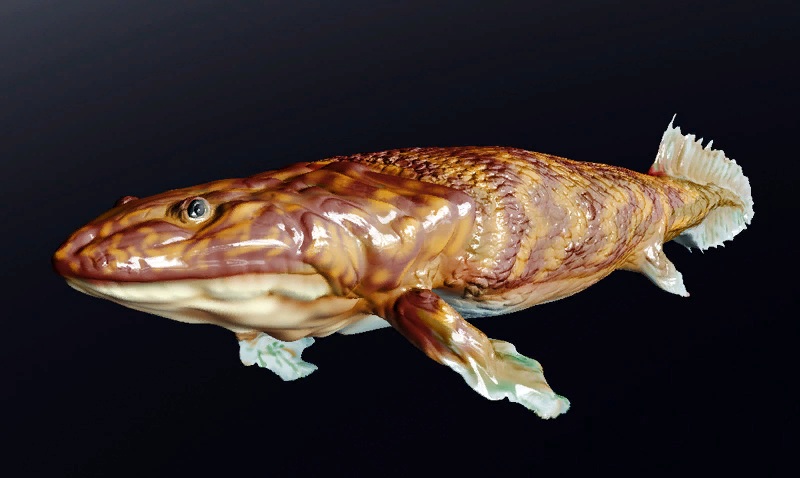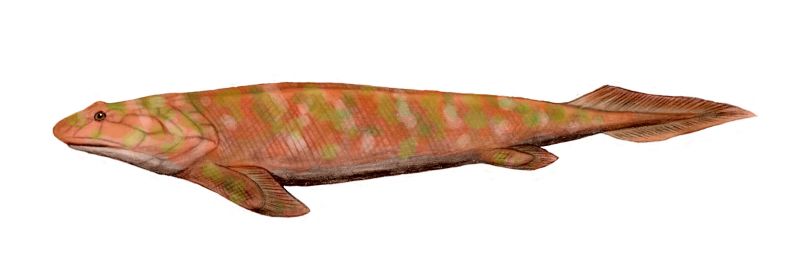|
Elpistostegalia
Elpistostegalia or Panderichthyida is an order of prehistoric lobe-finned fishes which lived during the Middle Devonian to Late Devonian period (about 385 to 374 million years ago). They represent the advanced tetrapodomorph stock, the fishes more closely related to tetrapods than the osteolepiform fishes. The earliest elpistostegalians, combining fishlike and tetrapod-like characters, are sometimes called fishapods, a phrase coined for the advanced elpistostegalian '' Tiktaalik''. Through a strict cladistic view, the order includes the terrestrial tetrapods. Palaeobiology of the elpistostegalians A rise in global oxygen content allowed for the evolution of large, predatory fish that were able to exploit the shallow tidal areas and swamplands as top predators. Several groups evolved to fill these niches, the most successful were the elpistiostegalians. In such environments, they would have been challenged by periodic oxygen deficiency. In comparable modern aquatic environment ... [...More Info...] [...Related Items...] OR: [Wikipedia] [Google] [Baidu] |
Lobe-finned Fishes
Sarcopterygii (; ) — sometimes considered synonymous with Crossopterygii () — is a taxon (traditionally a class or subclass) of the bony fishes known as the lobe-finned fishes. The group Tetrapoda, a mostly terrestrial superclass including amphibians, sauropsids ( reptiles, including dinosaurs and therefore birds) and synapsids (with mammals being the only extant group), evolved from certain sarcopterygians; under a cladistic view, tetrapods are themselves considered a subgroup within Sarcopterygii. The known extant non-tetrapod sarcopterygians include two species of coelacanths and six species of lungfishes. Characteristics Early lobe-finned fishes are bony fish with fleshy, lobed, paired fins, which are joined to the body by a single bone. The fins of lobe-finned fishes differ from those of all other fish in that each is borne on a fleshy, lobelike, scaly stalk extending from the body. The scales of sarcopterygians are true scaloids, consisting of lamellar bon ... [...More Info...] [...Related Items...] OR: [Wikipedia] [Google] [Baidu] |
Tiktaalik
''Tiktaalik'' (; Inuktitut ) is a monospecific genus of extinct sarcopterygian (lobe-finned fish) from the Late Devonian Period, about 375 Mya (million years ago), having many features akin to those of tetrapods (four-legged animals). It may have grown up to in length. Unearthed in Arctic Canada, ''Tiktaalik'' is a non-tetrapod member of Osteichthyes (bony fish), complete with scales and gills – but it has a triangular, flattened head and unusual, cleaver-shaped fins. Its fins have thin ray bones for paddling like most fish, but they also have sturdy interior bones that would have allowed Tiktaalik to prop itself up in shallow water and use its limbs for support as most four-legged animals do. Those fins and other mixed characteristics mark ''Tiktaalik'' as a crucial transition fossil, a link in evolution from swimming fish to four-legged vertebrates. This and similar animals might be the common ancestors of all vertebrate terrestrial fauna: amphibians, reptiles, birds, and ... [...More Info...] [...Related Items...] OR: [Wikipedia] [Google] [Baidu] |
Tetrapodomorpha
The Tetrapodomorpha (also known as Choanata) are a clade of vertebrates consisting of tetrapods (four-limbed vertebrates) and their closest sarcopterygian relatives that are more closely related to living tetrapods than to living lungfish. Advanced forms transitional between fish and the early labyrinthodonts, such as '' Tiktaalik'', have been referred to as "fishapods" by their discoverers, being half-fish, half-tetrapods, in appearance and limb morphology. The Tetrapodomorpha contains the crown group tetrapods (the last common ancestor of living tetrapods and all of its descendants) and several groups of early stem tetrapods, which includes several groups of related lobe-finned fishes, collectively known as the osteolepiforms. The Tetrapodamorpha minus the crown group Tetrapoda are the Stem Tetrapoda, a paraphyletic unit encompassing the fish to tetrapod transition. Among the characteristics defining tetrapodomorphs are modifications to the fins, notably a humerus with convex ... [...More Info...] [...Related Items...] OR: [Wikipedia] [Google] [Baidu] |
Stegocephalia
Stegocephali (often spelled Stegocephalia) is a group containing all four-limbed vertebrates. It is equivalent to a broad definition of Tetrapoda: under this broad definition, the term "tetrapod" applies to any animal descended from the first vertebrate with limbs and toes, rather than fins. This includes both the modern lineage of limbed vertebrates (the crown group, including modern amphibians, mammals, reptiles and birds) as well as a portion of the stem group, limbed vertebrates that evolved prior to the origin of the crown group. Members of the tetrapod stem group include the earliest limbed tetrapodomorphs such as ''Ichthyostega'' and ''Acanthostega,'' which evolved in the Devonian Period long before any modern form of tetrapod. Many paleontologists prefer a stricter definition of Tetrapoda which applies solely to the crown group, excluding earlier types of limbed tetrapodomorphs. Stegocephali was re-established to replace the broad definition of Tetrapoda, resolving the ... [...More Info...] [...Related Items...] OR: [Wikipedia] [Google] [Baidu] |
Panderichthys
''Panderichthys'' is a genus of extinction, extinct Sarcopterygii, sarcopterygian (lobe-finned fish) from the late Devonian period, about 380 Myr, Mya. ''Panderichthys'', which was recovered from Frasnian (early Late Devonian) deposits in Latvia, is represented by two species. ''P. stolbovi'' is known only from some snout fragments and an incomplete lower jaw. ''P. rhombolepis'' is known from several more complete specimens. Although it probably belongs to a sister group of the earliest tetrapods, ''Panderichthys'' exhibits a range of features transitional between Tristichopteridae, tristichopterid lobe-fin fishes (e.g., ''Eusthenopteron'') and early tetrapods. It is named after the German-Baltic paleontologist Christian Heinrich Pander. Possible tetrapod tracks dating back to before the appearance of ''Panderichthys'' in the fossil record were reported in 2010, which suggests that ''Panderichthys'' is not a direct ancestor of tetrapods, but nonetheless shows the traits that evolve ... [...More Info...] [...Related Items...] OR: [Wikipedia] [Google] [Baidu] |
Elpistostege
''Elpistostege'' is an extinct genus of finned tetrapodomorphs that lived during the late Givetian to early Frasnian ages of the Late Devonian epoch. Its only known species, ''E. watsoni'', was first described in 1938 by the British palaeontologist Thomas Stanley Westoll, based on a single partial skull roof discovered at the Escuminac Formation in Quebec, Canada. In 2010, a complete specimen was found in the same formation, which was described by Richard Cloutier and colleagues in 2020. It reveals that the paired fins of ''Elpistostege'' contained bones homologous to the phalanges (digit bones) of modern tetrapods; it is the most basal tetrapodomorph known to possess these bones. At the same time, the fins were covered in scales and lepidotrichia (fin rays), which indicates that the origin of phalanges preceded the loss of fin rays, rather than the other way around. Relationships An analysis conducted by Swartz in 2012 found ''Elpistostege'' to be the sister taxon of '' Ti ... [...More Info...] [...Related Items...] OR: [Wikipedia] [Google] [Baidu] |
Qikiqtania
''Qikiqtania'' (pronounced "kick-kiq-tani-ahh") is an extinct genus of elpistostegalian tetrapodomorph from the Late Devonian (early Frasnian stage) Fram Formation of Nunavut, Canada. The genus contains a single species, ''Q. wakei'', known from a partial skeleton. Analysis of the fin bones suggests that ''Qikiqtania'' was well-suited to swimming, and likely incapable of walking or supporting itself out of the water, as has been suggested for the closely related ''Tiktaalik''. Discovery and naming The holotype specimen of ''Qikiqtania'', NUFV 137, was discovered in 2004 in layers of the late Devonian (Frasnian)-dated Fram Formation of southern Ellesmere Island, Nunavut, Canada. The holotype specimen consists of lower jaws, partial left upper jaw and palate, gulars, ceratohyals, an articulated left pectoral fin and various articulated scales. The fossil remains of Qikiqtania were discovered east of the site where Tiktaalik was discovered, but from a slightly lower horizon ... [...More Info...] [...Related Items...] OR: [Wikipedia] [Google] [Baidu] |
Panderichthyidae
Panderichthyidae is a family of prehistoric lobe-finned fishes which lived during the Late Devonian period Period may refer to: Common uses * Era, a length or span of time * Full stop (or period), a punctuation mark Arts, entertainment, and media * Period (music), a concept in musical composition * Periodic sentence (or rhetorical period), a concept .... References Elpistostegalians Late Devonian fish Devonian bony fish Prehistoric lobe-finned fish families Late Devonian first appearances Late Devonian animals Late Devonian extinctions {{Devonian-fish-stub ... [...More Info...] [...Related Items...] OR: [Wikipedia] [Google] [Baidu] |
Tetrapod
Tetrapods (; ) are four-limbed vertebrate animals constituting the superclass Tetrapoda (). It includes extant and extinct amphibians, sauropsids ( reptiles, including dinosaurs and therefore birds) and synapsids ( pelycosaurs, extinct therapsids and all extant mammals). Tetrapods evolved from a clade of primitive semiaquatic animals known as the Tetrapodomorpha which, in turn, evolved from ancient lobe-finned fish (sarcopterygians) around 390 million years ago in the Middle Devonian period; their forms were transitional between lobe-finned fishes and true four-limbed tetrapods. Limbed vertebrates (tetrapods in the broad sense of the word) are first known from Middle Devonian trackways, and body fossils became common near the end of the Late Devonian but these were all aquatic. The first crown-tetrapods ( last common ancestors of extant tetrapods capable of terrestrial locomotion) appeared by the very early Carboniferous, 350 million years ago. The specific aquat ... [...More Info...] [...Related Items...] OR: [Wikipedia] [Google] [Baidu] |
Osteolepiformes
Osteolepiformes, also known as Osteolepidida, is a group of prehistoric lobe-finned fishes which first appeared during the Devonian period. The order contains the families Canowindridae, Megalichthyidae, Osteolepididae and Tristichopteridae. The order is generally considered to be paraphyletic because the characters that define it are mainly attributes of stem tetrapodomorphs. Below is a cladogram A cladogram (from Greek ''clados'' "branch" and ''gramma'' "character") is a diagram used in cladistics to show relations among organisms. A cladogram is not, however, an evolutionary tree because it does not show how ancestors are related to ... showing the paraphyly of Osteolepiformes compiled and modified from Ahlberg and Johanson (1998). See also Swartz (2012). Osteolepiformes is marked by the green bracket. References External linksTree of Life Tetrapodomorphs Prehistoric fish orders Paraphyletic groups {{paleo-lobefinned-fish-stub ... [...More Info...] [...Related Items...] OR: [Wikipedia] [Google] [Baidu] |
Middle Devonian
The Devonian ( ) is a geologic period and system of the Paleozoic era, spanning 60.3 million years from the end of the Silurian, million years ago (Mya), to the beginning of the Carboniferous, Mya. It is named after Devon, England, where rocks from this period were first studied. The first significant adaptive radiation of life on dry land occurred during the Devonian. Free-sporing vascular plants began to spread across dry land, forming extensive forests which covered the continents. By the middle of the Devonian, several groups of plants had evolved leaves and true roots, and by the end of the period the first seed-bearing plants appeared. The arthropod groups of myriapods, arachnids and hexapods also became well-established early in this period, after starting their expansion to land at least from the Ordovician period. Fish reached substantial diversity during this time, leading the Devonian to often be dubbed the Age of Fishes. The placoderms began dominat ... [...More Info...] [...Related Items...] OR: [Wikipedia] [Google] [Baidu] |
Per E
Per is a Latin preposition which means "through" or "for each", as in per capita. Per or PER may also refer to: Places * IOC country code for Peru * Pér, a village in Hungary * Chapman code for Perthshire, historic county in Scotland Math and statistics * Rate (mathematics), ratio between quantities in different units, described with the word "per" * Price–earnings ratio, in finance, a measure of growth in earnings * Player efficiency rating, a measure of basketball player performance * Partial equivalence relation, class of relations that are symmetric and transitive * Physics education research Science * Perseus (constellation), standard astronomical abbreviation * Period (gene) or ''per'' that regulates the biological clock and its corresponding protein PER * Protein efficiency ratio, of food * PER or peregrinibacteria, a candidate bacterial phylum Media and entertainment * PeR (band), a Latvian pop band * ''Per'' (film), a 1975 Danish film Transport * IATA co ... [...More Info...] [...Related Items...] OR: [Wikipedia] [Google] [Baidu] |






